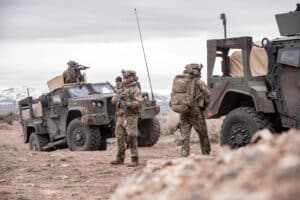BlueHalo, a leading defense contractor, announced plans to test its innovative LOCUST Laser Weapon System on a U.S. Marine Corps Joint Light Tactical Vehicle (JLTV). The testing aims to enhance the Marines’ capabilities in combating unmanned aerial systems (UAS) and other aerial threats. Jonathan Moneymaker, CEO of BlueHalo, highlighted the system’s versatility and potential during a recent interview with Seapower magazine.
The LOCUST system is designed to counter low-level aerial threats, including drones and incoming projectiles, through a combination of high-energy lasers, precision optics, and advanced targeting software. It integrates artificial intelligence (AI) to streamline the detection and engagement processes, crucial for dynamic combat scenarios. BlueHalo’s approach combines various defense strategies, from passive surveillance to active engagement, reflecting a shift toward integrated, multi-modal defense systems in contemporary warfare.


Previously, BlueHalo has successfully deployed similar systems with the U.S. Army, delivering two Palletized High Energy Laser (P-HEL) systems, now operational in undisclosed conflict zones.
The upcoming tests on the Marine Corps’ JLTV highlight the system’s adaptability and the potential for broader application across military branches. The Marine Corps integration aligns with ongoing efforts to deploy these capabilities on naval vessels, with discussions already underway regarding their deployment in strategic locations like the Red Sea.
The development and testing of the LOCUST system are conducted in collaboration with various defense bodies, including the Department of the Navy’s Ground-Based Air Defense program and the U.S. Army Rapid Capabilities and Critical Technologies Office (RCCTO). This partnership underscores a unified approach to developing next-generation defense technologies.
In addition to its military applications, the LOCUST system is a part of BlueHalo’s broader portfolio, developed primarily in Albuquerque, New Mexico, with additional facilities across the United States.
Expanded Coverage:






